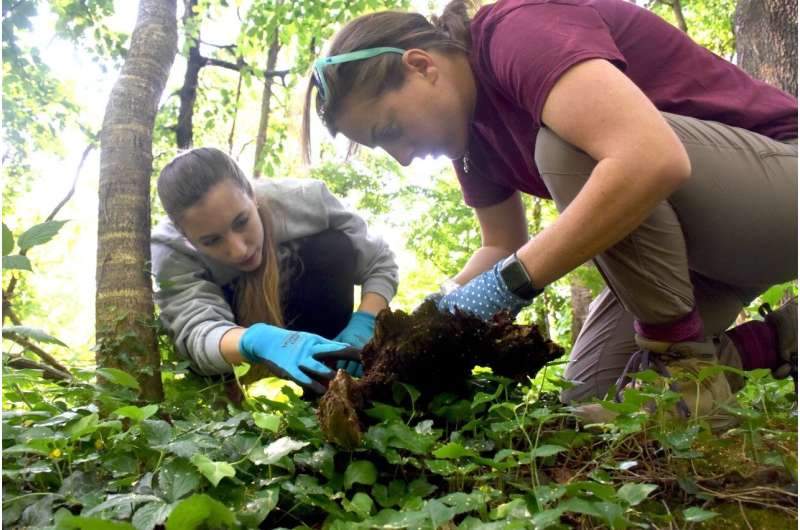Science
Virginia Tech Chemists Uncover New Millipede Compounds for Pain Relief

Researchers at Virginia Tech have made a significant discovery involving millipede secretions that may lead to advancements in pain treatment. Chemist Emily Mevers and her team identified a new set of complex compounds known as andrognathanols and andrognathines, which influence specific neuroreceptors in ant brains. This research, published on June 25, 2025, in the Journal of the American Chemical Society, highlights the potential for these compounds to contribute to drug development.
Exploring Millipede Chemistry
Mevers specializes in utilizing the chemistry found in underexplored ecological niches, such as millipedes, for drug discovery. The team gathered samples of the millipede species Andrognathus corticarius from leaf litter in Stadium Woods on the Virginia Tech campus. By employing various analytical techniques, they analyzed the compounds secreted by the millipedes’ defensive glands. These secretions not only deter predators but also help millipedes communicate their presence to other members of their species.
Despite their abundance in various environments, many aspects of millipede biology, including their habitats, numbers, and behaviors, remain largely unexamined. Mevers is collaborating with millipede expert Paul Marek from the entomology department to address these knowledge gaps and explore the potential therapeutic applications of their findings.
Implications for Drug Development
Previously, Mevers and Marek studied another millipede species, Ishcnocybe plicata, native to the Pacific Northwest. They discovered that related alkaloids effectively interacted with a neuroreceptor known as Sigma-1, suggesting these compounds could have valuable pharmacological properties for treating pain and other neurological disorders. The recent discovery indicates that the new alkaloids also trigger similar interactions.
The newly identified compounds are secreted from the Hokie millipede when physically disturbed, leading to disorientation in ants, a natural predator of the millipede. Some of these compounds appear to modulate the Sigma-1 neuroreceptor, reinforcing their potential relevance in pain management.
The next step for Mevers and her team involves synthesizing these complex compounds in larger quantities for further study. “These compounds are quite complex, so they’re going to take some time to synthesize in the lab,” Mevers explained. Once they can produce larger amounts, the team will delve deeper into understanding the properties and potential biomedical applications of these intriguing substances.
For additional insights, the full research paper titled “The Discovery of Complex Heterocycles from Millipede Secretions” is available in the Journal of the American Chemical Society.
This groundbreaking research not only sheds light on the chemistry of millipedes but also opens new avenues for the development of innovative treatments for pain relief, potentially improving the quality of life for many individuals.
-

 Health3 months ago
Health3 months agoNeurologist Warns Excessive Use of Supplements Can Harm Brain
-

 Health3 months ago
Health3 months agoFiona Phillips’ Husband Shares Heartfelt Update on Her Alzheimer’s Journey
-

 Science2 months ago
Science2 months agoBrian Cox Addresses Claims of Alien Probe in 3I/ATLAS Discovery
-

 Science2 months ago
Science2 months agoNASA Investigates Unusual Comet 3I/ATLAS; New Findings Emerge
-

 Science1 month ago
Science1 month agoScientists Examine 3I/ATLAS: Alien Artifact or Cosmic Oddity?
-

 Entertainment5 months ago
Entertainment5 months agoKerry Katona Discusses Future Baby Plans and Brian McFadden’s Wedding
-

 Science1 month ago
Science1 month agoNASA Investigates Speedy Object 3I/ATLAS, Sparking Speculation
-

 Entertainment4 months ago
Entertainment4 months agoEmmerdale Faces Tension as Dylan and April’s Lives Hang in the Balance
-

 World3 months ago
World3 months agoCole Palmer’s Cryptic Message to Kobbie Mainoo Following Loan Talks
-

 Science1 month ago
Science1 month agoNASA Scientists Explore Origins of 3I/ATLAS, a Fast-Moving Visitor
-

 Entertainment2 months ago
Entertainment2 months agoLewis Cope Addresses Accusations of Dance Training Advantage
-

 Entertainment3 months ago
Entertainment3 months agoMajor Cast Changes at Coronation Street: Exits and Returns in 2025









